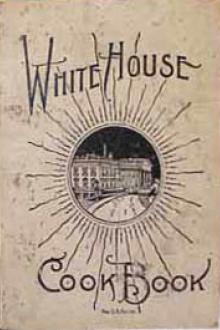The Whitehouse Cookbook (1887), Hugo Ziemann [world of reading .TXT] 📗

- Author: Hugo Ziemann
- Performer: -
Book online «The Whitehouse Cookbook (1887), Hugo Ziemann [world of reading .TXT] 📗». Author Hugo Ziemann
TO WASH WHITE THREAD LACE. No. 2.
To wash white lace, cover a bottle with linen, stitched smoothly to fit the shape. Wind the lace about it, basting both edges to the linen. Wash on the bottle, soaping and rinsing well, then boil in soft water. Dry in the sun. Clip the basting threads and do not iron. If carefully done it will look like new lace.
TO CLEAN SILKS OR RIBBONS.
Half a pint of gin, half a pound of honey, half a pound of soft soap, one-eighth of a pint of water.
Mix the above ingredients together; then lay each breadth of silk upon a clean kitchen table or dresser, and scrub it well on the soiled side with the mixture. Have ready three vessels of cold water; take each piece of silk at two corners, and dip it up and down in each vessel, but do not wring it; and take care that each breadth has one vessel of quite clean water for the last dip. Hang it up dripping for a minute or two, then dab in a cloth, and iron it quickly with a very hot iron.
Where the lace or silk is very much soiled, it is best to pass them through a warm liquor of bullock's gall and water; rinse in cold water; then take a small piece of glue, pour boiling water on it, and pass the veil through it, clap it, and frame to dry. Instead of framing, it may be fastened with drawing-pins closely fixed upon a very clean paste, or drawing-board.
TO CLEAN BLACK DRESS SILKS.
One of the things "not generally known," at least in this country, is the Parisian method of cleaning black silk; the modus operandi is very simple, and the result infinitely superior to that achieved in any other manner. The silk must be thoroughly brushed and wiped with a cloth, then laid flat on a board or table, and well sponged with hot coffee, thoroughly freed from sediment by being strained through muslin. The silk is sponged on the side intended to show; it is allowed to become partially dry, and then ironed on the wrong side. The coffee removes every particle of grease, and restores the brilliancy of silk, without imparting to it either the shiny appearance or crackly and papery stiffness obtained by beer, or, indeed, any other liquid. The silk really appears thickened by the process, and this good effect is permanent. Our readers who will experimentalize on an apron or cravat, will never again try any other method.
TO WASH FEATHERS.
Wash in warm soap-suds and rinse in water a very little blued; if the feather is white, then let the wind dry it. When the curl has come out by washing the feather or getting it damp, place a hot flat-iron so that you can hold the feather just above it while curling. Take a bone or silver knife, and draw the fibres of the feather between the thumb and the dull edge of the knife, taking not more than three fibres at a time, beginning at the point of the feather and curling one-half the other way. The hot iron makes the curl more durable. After a little practice one can make them look as well as new feathers. Or they can be curled by holding them over the stove or range, not near enough to burn; withdraw and shake out; then hold them over again until they curl. When swansdown becomes soiled, it can be washed and look as good as new. Tack strips on a piece of muslin and wash in warm water with white soap, then rinse and hang in the wind to dry. Rip from the muslin and rub carefully between the fingers to soften the leather.
INCOMBUSTIBLE DRESSES.
By putting an ounce of alum or sal ammoniac in the last water in which muslins or cottons are rinsed, or a similar quantity in the starch in which they are stiffened, they will be rendered almost uninflammable; or, at least, will with difficulty take the fire, and if they do, will burn without flame. It is astonishing that this simple precaution is so rarely adopted. Remember this and save the lives of your children.
HOW TO FRESHEN UP FURS.
Furs when taken out in the fall are often found to have a mussed, crushed-out appearance. They can be made to look like new, by following these simple directions: Wet the fur with a hair-brush, brushing up the wrong way of the fur. Leave it to dry in the air for about half an hour, and then give it a good beating on the right side with a rattan. After beating it, comb it with a coarse comb, combing up the right way of the fur.
NOVEL DRESS MENDING.
A novel way of mending a woolen or silk dress in which a round hole has been torn, and where only a patch could remedy matters, is the following: The frayed portions around the tear should be carefully smoothed, and a piece of the material, moistened with very thin muscilage, placed under the hole. A heavy weight should be put upon it until it is dry, when it is only possible to discover the mended place by careful observation.
TO RENEW OLD CRAPE.
Place a little water in a tea-kettle, and let it boil until there is plenty of steam from the spout; then, holding the crape in both hands, pass it to and fro several times through the steam, and it will be clean and look nearly equal to new.
TO RAISE THE PILE ON VELVET.
To raise the pile on velvet, put on a table two pieces of wood; place between them, bottom side up, three very hot flat-irons, and over them lay a wet cloth; hold the velvet over the cloth, with the wrong side down; when thoroughly steamed, brush the pile with a light wisp, and the velvet will look as good as new.
TO CLEAN KID GLOVES.
Make a thick mucilage by boiling a handful of flax-seed; add a little dissolved toilet soap; then, when the mixture cools, put the gloves on the hands and rub them with a piece of white flannel wet with the mixture. Do not wet the gloves through. Or take a fine, clean, soft cloth, dip it into a little sweet milk, then rub it on a cake of soap, and rub the gloves with it; they will, look like new.
Another good way to clean any color of kid gloves is to pour a little benzine into a basin and wash the gloves in it, rubbing and squeezing them until clean. If much soiled, they must be washed through clean benzine, and rinsed in a fresh supply. Hang up in the air to dry.
STARCH POLISH.
Take one ounce of spermaceti and one ounce of white wax; melt and run it into a thin cake on a plate. A piece the size of a quarter dollar added to a quart of prepared starch gives a beautiful lustre to the clothes and prevents the iron from sticking.
FOR CLEANING JEWELRY.
For cleaning jewelry there is nothing better than ammonia and water. If very dull or dirty, rub a little soap on a soft brush and brush them in this wash, rinse in cold water, dry first in an old handkerchief and then rub with buck or chamois skin. Their freshness and brilliancy when thus cleaned cannot be surpassed by any compound used by jewelers.
TO CLEAN SILVER PLATE.
Wash well in strong, warm soap-suds, rinse and wipe dry with a dry soft cloth; then mix as much hartshorn powder as will be required into a thick paste, with cold water; spread this over the silver, with a soft cloth, and leave it for a little time to dry. When perfectly dry brush it off with a clean soft cloth, or brush and polish it with a piece of chamois skin. Hartshorn is one of the best possible ingredients for plate powder for daily use. It leaves on the silver a deep, dark polish, and at the same time does not injure it. Whiting, dampened with liquid ammonia, is excellent also.
TO REMOVE STAINS FROM MARBLE.
Mix together one-half pound of soda, one-half pound of soft soap and one pound of whiting. Boil them until they become as thick as paste, and let it cool. Before it is quite cold, spread it over the surface of the marble and leave it at least a whole day. Use soft water to wash it off, and rub it well with soft cloths. For a black marble, nothing it better than spirits of turpentine.
Another paste answers the same purpose: Take two parts of soda, one of pumice stone and one of finely-powdered chalk. Sift these through a fine sieve and mix them into a paste with water. Rub this well all over the marble and the stains will be removed; then wash it with soap and water and a beautiful bright polish will be produced.
TO WHITEN WALLS.
To whiten walls, scrape off all the old whitewash, and wash the walls with a solution of two ounces of white vitriol to four gallons of water. Soak a quarter of a pound of white glue in water for twelve hours; strain and place in a tin pail in a kettle of boiling water. When melted, stir in the glue eight pounds of whiting and water enough to make it as thick as common whitewash. Apply evenly with a good brush. If the walls are very yellow, blue the water slightly by squeezing in it a flannel blue-bag.
Before kalsomining a wall all cracks should be plastered over. Use plaster of Paris. Kalsomine may be colored easily by mixing with it yellow ochre, Spanish brown, indigo; squeeze through a bag into the water, etc.
PAPER-HANGERS' PASTE.
To make paper-hangers' paste, beat up four pounds of good, white wheat flour (well sifted previously) in sufficient cold water to form a stiff batter. Beat it well in order to take out all lumps, and then add enough cold water to make the mixture of the consistency of pudding batter. To this add about two ounces of well-pounded alum. Pour gently and quickly over the batter boiling water, stirring rapidly at the same time, and when it is seen to lose the white color of the flour, it is cooked and ready. Do not use it, however, while hot, but allow it to cool. Pour about a pint of cold water over the top to prevent a skin from forming. Before using, the paste should be thinned by the addition of cold water.
TO WASH COLORED GARMENTS.
Delicately colored socks and stockings are apt to fade in washing. If they are soaked for a night in a pail of tepid water containing a half pint of





Comments (0)